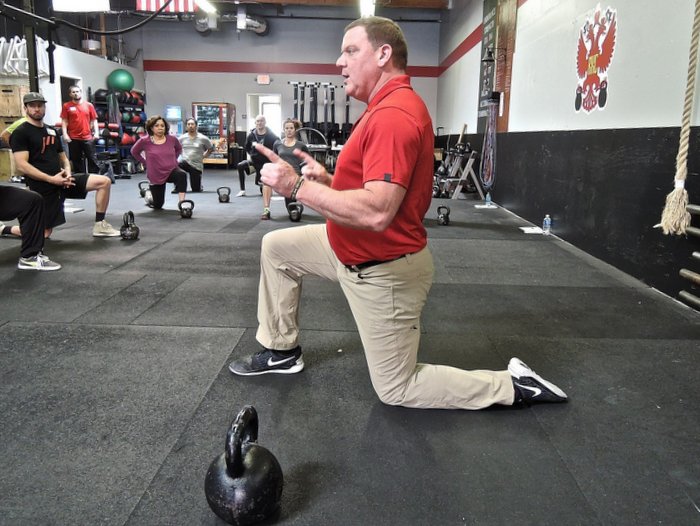
As I review my half-century in the weightroom (I started lifting in 1965), I begin to see our world of strength through the lens of something Arthur Schopenhauer noted:
“When you look back on your life, it looks as though it were a plot, but when you are into it, it’s a mess: just one surprise after another. Then, later, you see it was perfect.”
With my massive collection of Strength and Health magazines and the short-lived American Athlete magazine, I can pick up an issue from just after World War II and see articles about how to repair the wounded warriors. The training presented for injured veterans was just like what most people now consider training: laying down on machines, isolation work and a few sets of about eight to ten reps. While that kind of training is perfect for someone with compromised health and fitness, it’s not optimal for elite sports performance!
I can read articles from the 1950s and see kettlebells used for leverage work, curls and grip training. I have found swing articles from the 1960s that emphasize dangerous overflexion at the hinge and overextension at the plank.
Yes, kettlebell work had basically devolved into a mess. Powerlifting had pushed Olympic lifting out of the way, and the bench press became the answer to every question. It wasn’t a good answer. Some excellent coaches and trainers were pushing the strength envelope, but others were bogging us down. Speaking of bogging us down in the mess, one famous strength coach advocated using mud as resistance and noted “progress will be made.” It works for pigs, so why not?
“Whadduya bench?” became the fitness standard. We saw the rise of the machines for leg training—as if leg presses indicated anything in the field of play or nature. The world of lifting was a mess.
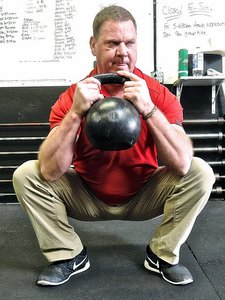
And then, the kettlebell returned and all credit—all credit—goes to Dragon Door if you wish to be historically sincere. As an Olympic lifter, I couldn’t fathom how these kettlebells could help me. I was surprised when I learned that the swing (done correctly and not how I first did it) made me a better Olympic lifter when I better understood the hinge. As much as I knew how to coach the squat, the horns on the kettlebell allowed me to teach pushing out the knees with the elbows. And, I invented the goblet squat.
One arm pressing trumped most of the overhead work I was doing with throwers as it demanded the hard work of the whole chain of anti-rotation muscles.
I became a better coach with kettlebells. But, I wouldn’t have been ready for them when I first saw them in Strength and Health.
As if kettlebells were a part of my coaching life’s plot, they arrived exactly when they needed to arrive…like what Gandalf says about wizards.
I learned enough to fill my head at my RKC certification in San Jose in 2008. Oddly, I learned even more a few months later as an assistant at an RKC at UCLA. And, I learned more again and again and again…
I started coaching in 1979, and thirty years later my head was being filled again!
I tell people all the time, you can’t think through a ballistic movement. To understand the swing, snatch and clean, you need to “hear” the standards, drills, corrections, and the insights several times before it “clicks.” Oddly, your technique might be seamless, but you might not be able to coach someone who has a simple error in their technique. Or, you might be able to “see” the problem, but your own technique is muddled.
When it comes to the goblet squat, get-up and press, are you really prying, packing or patterning the correct path? Or, are you just getting the reps in? Are you putting the kettlebell down like a professional every single time? How is your breathing? Your tension?
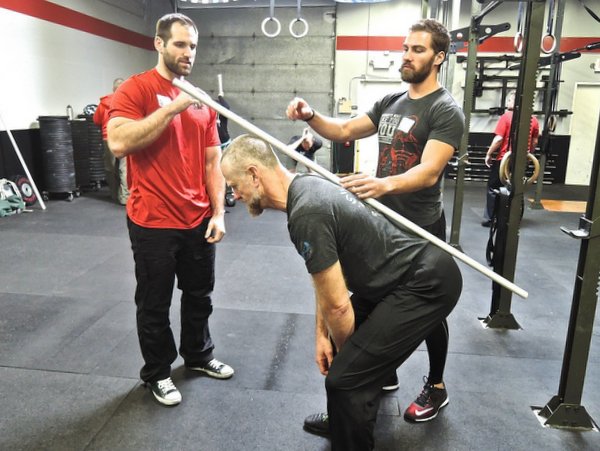
You need other eyes. You need community.
You need to recertify!
I work with a handful of RKCs daily. It is a rare few weeks, when someone does NOT take me aside and point out that I’m making a basic error. On paper, I am a Master RKC—but in my own training, I am just another person swinging a kettlebell. I try not to get lazy. I try to stay packed and attack the hinge.
…but sometimes I don’t.
Over time, skills degrade. “Safety is part of performance,” except when we get tired, lazy or pressed for time. There are no excuses for lack of safety!
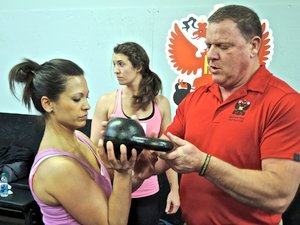 Recertifying will get eyes on you again. Recertifying for $500 means three days of expert teaching and evaluation from at least three people, if not many, many more. This is a bargain compared to hiring a personal trainer.
Recertifying will get eyes on you again. Recertifying for $500 means three days of expert teaching and evaluation from at least three people, if not many, many more. This is a bargain compared to hiring a personal trainer.
Whenever anyone returns from a retreat, a clinic, conference, or workshop, the enthusiasm and excitement drips off of them. They have clear eyes and a missionary zeal.
When I first embarked on my RKC journey, I came home and converted everyone I knew to the “Kettlebell Crusade”.
But, like all things, this wanes over time. It’s not bad or good, but without community, without an ongoing dialogue, the battery runs out of excitement.
Outside of an annual visit to “Kettlebell Kamp”, the best thing I can recommend is recertifying.
For as much as I learn during the day, I think I learn more at night. At dinner, we exchange emails, gym insights, training mistakes, and fixes. A wealth of information seems to fit perfectly on a napkin. My favorite RKC dinner moments are when John Du Cane gives me a “MUST” read book recommendations. I am forever grateful for his recommendations.
JDC does an interesting thing, when he asks for my book recommendations, he opens his phone and buys the books as I list them. If you believe in Shark Habits (“One bite!”) like I do, then this is a good example to follow.
It’s a rare day when I do NOT get a text, email, post, or message from someone I met at an RKC. It’s nice to recommit to the shared experience. But, people still move on, drop off and walk away. Recertify your way into a new group of people who can walk the walk with you.
For example, if you were certified before 2008, you missed the goblet squat. Since then, the get-up has been revamped several times. Finally, I think we’re teaching it with the appropriate steps, corrections, and drills. The sections on programming are tighter and clearer with more actual programs.
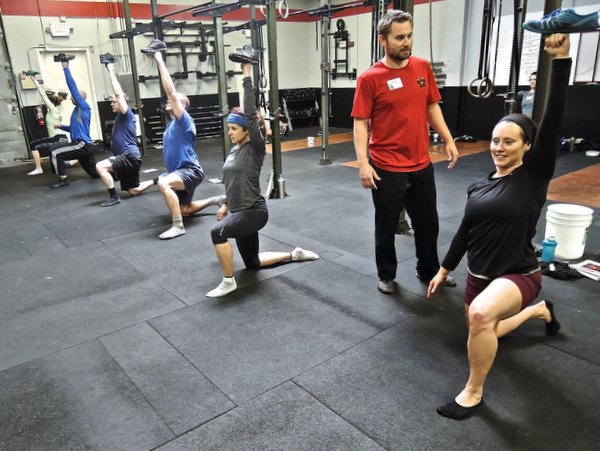
There are more swing drills and clearer correctives. In other words, the RKC is evolving. There was nothing wrong with the Sig Klein articles in Strength and Health, but kettlebells and kettlebell training has evolved. I rarely wear leopard skin and lace up boots when I train. (Note: I said when I train. My gym is judgment free, so you would be welcome to do what you need to do.)
I enjoy being part of this evolution. As much as I loved the original notion of the “kettlebell revolution”, the kettlebell won. If you are keeping score, I enjoy the kettlebell evolution ever more. Hundreds of people teaching thousands of clients with millions of swings will produce new insights, new ways of teaching and greater clarity with problems and issues.
I believe in investing in my continuing education. I sit in the front row at workshops and sign up for a weekend certification or conference at least once a year. It’s hard to find a better deal than the $500 for the three-day RKC recertification.
In 1993, with two little girls in the house, I flew out for a week-long discus camp at Dennison University. For that week, Tiffini worked full-time along with fulfilling full-time mommy and daddy work. It cost a lot—money we didn’t have—and it was a ton of work for me.
But, it changed my life. I have gone back every year since. It sharpened my coaching toolkit, opened my mind to new possibilities, and honed my own techniques.
We have earned back, in every way, this investment.
Look at recertification with the same lens: for $500, you are recertified for three years. More importantly, you’ll have a chance to fill your quiver of arrows, add new tools to your toolkit, experience a dynamic new community, learn new and evolving information, and get new sets of eyes on your technique.
The question shouldn’t be “why recertify?,” it should be “why not?”
It is the perfect way to plot your career.
****
Master RKC, Dan John is the author of numerous fitness titles including the best selling Never Let Go and Easy Strength.
Dan has spent his life with one foot in the world of lifting and throwing, and the other foot in academia. An All-American discus thrower, Dan has also competed at the highest levels of Olympic lifting, Highland Games and the Weight Pentathlon, an event in which he holds the American record.
Dan spends his work life blending weekly workshops and lectures with full-time writing, and is also an online religious studies instructor for Columbia College of Missouri. As a Fulbright Scholar, he toured the Middle East exploring the foundations of religious education systems. For more information visit: http://danjohn.net
From the RKC manual:
There are four compelling reasons to recertify and keep your RKC status.
The number one reason to recertify is to keep your skill level up to the current standards of the RKC. This signifies the importance you place on continuing your education and keeping your personal athletic skills sharp.
The second reason to recertify is the obvious benefit you receive from the Dragon Door marketing machine, by being listed as an RKC on the DragonDoor.com website. This can lead potential clients to you and give you a presence within and outside your on community.
The third reason to recertify is the ability to network with like-minded trainers. This is an extremely valuable tool to help keep you current, offer support and advice in all manners of kettlebell training and professional issues.
The fourth reason, is to continue to receive a discount on purchases of kettlebell and Dragon Door kettlebell products. Orders can be placed by logging you’re your instructor account online, where qualifying products are automatically discounted, or by calling DragonDoor.com customer service at 1-800-899-5111 or internationally 214-258-0134. Identifying yourself as a currently certified instructor is required, so the phone agents know to use your account to place your order.